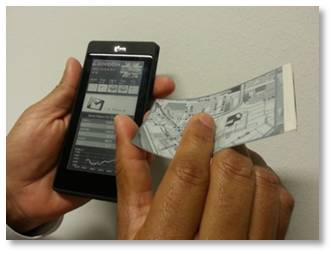As smartphone and tablet makers desperately search for points of differentiation they will try to push the limits of performance on several fronts to extremes. The password pill and the display-cover display are two of the stranger extreme features on the way.
Extreme inter-connectivity is one of the more useful features that is appearing in new products. Phones will wirelessly link and sync with screens and sensors in the user’s vicinity.
For example, there is already activity to equip phones with NFC in order to transfer data by tapping the phone to a set-top box or TV. More context-aware automatic wireless linking is coming too. In addition, giant e-commerce, software, and semiconductor companies are said to be creating Wi-Fi networks to compete with cellular services.
You can also expect extreme sensor support. On a more intimate (and bizarre) scale certain companies and universities are experimenting with tattoos to provide sensor and control capabilities for mobile devices. In the works are new kinds of proximity sensors, accelerometers, pressure sensors/altimeters, chemical sensors and more.
Biomedical sensors have lots of potential. For example, non-invasive glucose monitoring and vein mapping is being developed by a major cell phone maker now as a way to enhance fitness and health sensing. Vein mapping is already on PCs in Japan for user ID.
Another angle on human-to-machine interaction is the password pill presented by DARPA alums now working at a major cell phone maker. Once swallowed, the pill is powered up by electrolytes in the body to create a signal making one’s entire body into an authentication token. When the user touches the phone, computer, car, or whatever, the user is thus authenticated into that system.
Watching the display-cover display
Prototypes of extreme screens are now available. These bi-stable, reflective displays used in e-books merge with wireless technology to create a type of external or secondary smartphone screen. The idea is to allow the phone to send an image like a map to a secondary screen.
Being bi-stable a secondary screen can retain the image without power so the user can refer to it while driving without having to turn on the phone again. The idea lends itself well to tablet covers which scream out for a dual purpose such as a secondary display, an extra battery, a solar panel or an external flat speaker. Apple has a patent on related to this notion.
Several smartphone makers have clear strategies to take photography to extremes. One company already has a 40 megapixel camera on the market. Others are using detachable lenses that connect wirelessly to the phone and tablet.
Major smartphone and chipset makers are experimenting with multi-lens arrays to make computational light-field cameras. The technology captures complete depth of field information about a scene allowing the user to refocus after the fact to highlight different subjects, change the scale, change backgrounds, apply different filtering and do other edits without a PC.
On the display side, we may be moving into the overkill zone with extreme resolution. Screen makers have already demonstrated displays with twice the performance of 1080-progressive.
It’s reasonable to ask why anyone would want a small screen with higher resolution than one’s eyes can practically discern. However, the point is that this technology is already out and once something exists it is a very short journey to copycat behavior.
Extreme security on mobile platforms — the fingerprint sensor that appeared on the new iPhone 5S — makes more sense especially as users store more financial and personal data on them. Wall Street seems to love companies investing in mobile security.
Tangible hardware-based security techniques can make users feel more trust in the system and bolster mobile commerce. Apple, Samsung, Huawei/Hisilicon, LG, Lenovo and others are increasingly designing their own mobile processors, devices likely to boast more cryptography and hardened features.
Among other extreme features expect more advanced voice processing; louder, bigger, and flatter speakers; and advanced DSP-based sound processing.
— Bill Boldt is a marketing executive, market researcher and consultant, and can be reached at Boldtassoc@gmail.com
More articles by Bill Boldt…..
lang: en_US
Share this post via:








Quantum Advantage is About the Algorithm, not the Computer